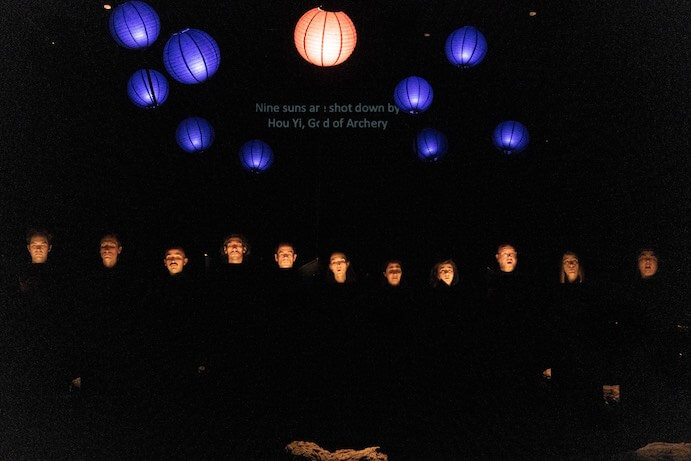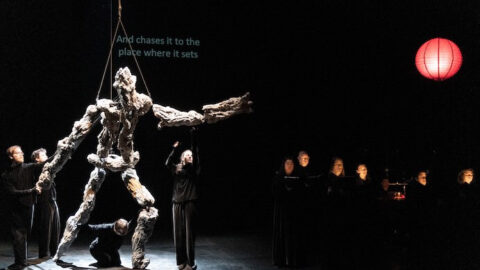As with his opera An American Soldier or the quasi-improvisational test of boundaries in Resonant Theatre: The Sonic Great Wall, Huang Ruo’s Book of Mountains and Seas showcases his signature ability to draw from a variety of classical traditions and craft cohesive, compelling music-theater. Presented by Beth Morrison Projects and St. Ann’s Warehouse, the work was originally slated for PROTOTYPE 2022 but was canceled due to pandemic safety concerns and rescheduled for performances on March 15-20, 2022. In this production directed by designer and puppeteer Basil Twist, twelve Trinity Wall Street Choir singers and percussion accompany stories told by six puppeteers. More than half of St. Ann’s Warehouse was used as a backstage: a large black circle extending almost to the ceiling blocked off space for the driftwood, lanterns, silk, and poles that would transform into grand mountains, rivers, stars, and monsters.
The Chinese text Book of Mountains and Seas, transcribed in the 4th century B.C., has 18 chapters and hundreds of mythical characters. From this original source material, Huang Ruo’s choral-theater work presents four fables that situate Earth within a celestial context of beauty and conflict. “The Legend of Pan Gu,” the first of two creation myths, teaches that Earth was created by 18,000 years of effort and sacrifice by the giant Pan Gu. In the third myth, “The Ten Suns,” we learn that Earth originally had ten Suns who kept a strict rotation of appearance. To a starry soundtrack of hand cymbals and singing bowls (percussionists Michael Murphy and John Ostrowski), the Suns abandon their schedule in boredom and begin to burn up the Earth. Their father, God of Archery, shoots nine Suns down to save Earth, and the one spared star recommits to a regular schedule.

Offsetting the two creation myths are tales of individual struggles with nature. “The Spirit Bird” tells of a princess who drowns and becomes a bird, determined to exact revenge on the ocean that killed her. This scene was spectacularly tragic and beautiful: two puppeteers stretched a large sheet of white silk across the stage and shook it under Poe Saegusa’s exquisite lighting design; another puppeteer swirled a swath of white and pink silk attached to a pole, swooping and billowing through the air as a bird.
The final fable’s destructive wooden giant, “Kua Fu Chasing the Sun,” is also driven by a futile quest, willing to destroy the Earth to achieve it. Humans never directly appear in the chosen myths; they were created last and seem to be inconsequential, although the human tendencies of desire, aggression, and revenge are present. Kua Fu is only called a giant — an impressive monster animated by five puppeteers on the ground and a sixth on the catwalk above — but he is certainly a close relative of human arrogance.
Why stage marvelous puppetry and not an opera with sung roles? Huang Ruo’s choice to avoid individual characters created a distinctly human atmosphere for tales that demote humans to nature’s periphery. The manual story animation underscored an otherworldly sense of time, and the choristers were terrific maintaining an entrancing soundscape. Most of their sound was ethereal, but the score did have a dramatic arc evolving from pale meditative layers and varied homophonic textures into polyphony and strong rhythmic drives that accelerated into the final myth. The choir’s blend, lack of vibrato, and occasional ornaments was neither Western nor operatic; gongs and marimba provided momentum throughout.

The music never distracted from the entrancing puppeteering (Lute Breuer, Ben Elling, Rosa Elling, Alexandra Goss, Rachel Schapira, Ashley Winkfield), and only once did the illusion truly crash. In “The Ten Suns,” ten lanterns seemed to float onstage of their own accord. Suddenly they advanced toward the audience, hanging over the first few rows in a jarring confrontation between the puppeteers and the audience that exposed the trick. Perhaps this personal and threatening moment within the generally abstract experience was worth the cost, but it seemed abrupt and out of place.
Throughout the production, extensive Mandarin subtitles were projected on the set wall; English subtitles were sparse though effective. Half of the choir’s text was sung in Mandarin, and the other half in a language invented by Huang Ruo. As an English speaker who does not read or speak Mandarin, I enjoyed the artistic presentation of the projections and experienced a mixture of comprehension and abstraction. I imagine the effect was similar for Mandarin speakers hearing their language interspersed with nonsense syllables, and this tri-lingual approach created a marvelous shared experience. An audience member could speak all or none of the languages and still have a deep aesthetic impression of the shared human condition in the universe.
Book of Mountains and Seas never forgets its human audience, arousing a surprising amount of connection to its mythical characters and honoring nature through elegant, sensual storytelling. This is its triumph.
I CARE IF YOU LISTEN is an editorially-independent program of the American Composers Forum, funded with generous donor and institutional support. Opinions expressed are solely those of the author and may not represent the views of ICIYL or ACF.
A gift to ACF helps support the work of ICIYL. For more on ACF, visit the “At ACF” section or composersforum.org.
























